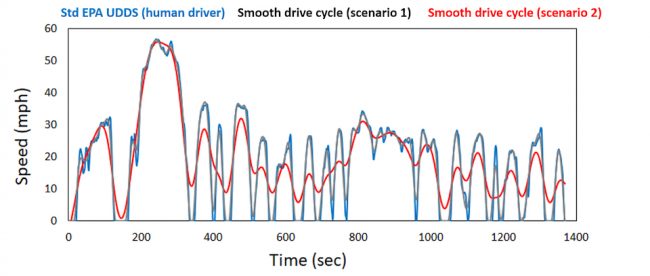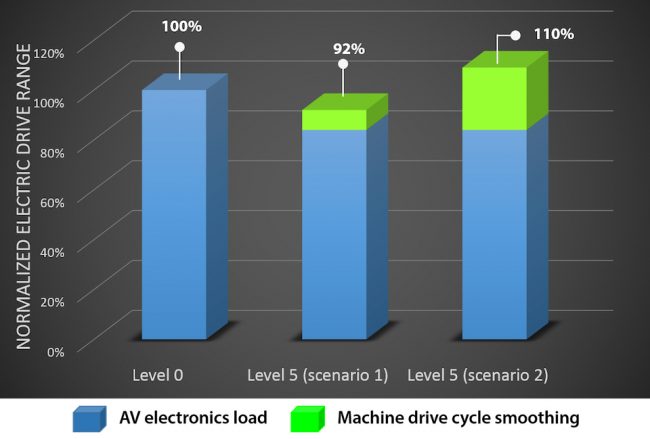Vehicle autonomy and electrification: a perfect match
By 2030, nearly 25% of all miles driven in the United States could be in shared autonomous electric vehicles (EVs), according to a study by the Boston Consulting Group [1]. Most autonomous vehicles announced by automakers or in fleet testing have either full electric or hybrid powertrains. An electric powertrain offers greater fuel efficiency and reduced CO2 emissions than fossil-fuel alternatives, and is an easier platform upon which to build the drive-by-wire systems needed for vehicle autonomy. As battery prices keep dropping, electric traction is also becoming attractive, especially for owners of ride-sharing fleets, because of its relatively low cost of ownership.
However, integrating vehicle autonomy systems into electric powertrains isn’t a straightforward win. For example, the power demands of the additional electronics needed to implement autonomy in an EV reduces its range. This article examines some key challenges and cost-reduction and optimization opportunities that come with using electric powertrains in level 4/5 autonomous vehicles.
How vehicle autonomy affects EV range
Fully autonomous cars (level 5) have many more electronic systems (sensors, sensor fusion subsystems, ECUs), than those driven by humans. With a fully electric powertrain, the vehicle autonomy systems are powered by the traction battery, through a DC-DC converter to the 12V line, which reduces the vehicle’s range. On the other hand, machine driving is expected to be smoother than human driving, which will increase the efficiency with which battery energy is used and so the EV’s range. These tradeoffs become a lot more interesting if we quantify the end effect.
Consider a level-5 autonomous, EV with 30 sensors (lidars, radars, and cameras), and one sensor fusion subsystem with centralized, raw sensor-data fusion based on the DRS360 architecture [2], with a power consumption of 100W. Total load for this example is 400W. It’s not yet clear how the driving profile of a connected autonomous vehicle will differ from a human-driven vehicle, and this is an area of active research. As automobile OEMs increasingly rely upon virtual traffic scenarios and vehicle-driving simulations for autonomous vehicle testing, simulation tools such as PreScan [3] from Siemens can help determine how driving profiles will change under machine driving.
For this example, we’ll use two scenarios from the simulated drive-cycle smoothing research conducted by Dr Kockelman’s group at the University of Texas in Austin [4,5]. Scenario 1 represents a moderate smoothing of the drive profile throughout the cycle, especially as the vehicle comes to a complete stop or reaches maximum acceleration. Scenario 2 represents significantly more smoothing to a point where the connected autonomous vehicle can anticipate upcoming stops during city driving and therefore slow down or accelerate accordingly, without coming to a complete stop. The overall commute time remains the same for both scenarios. (Figure 1)
For city driving at an ambient temperature of 25oC, our analysis shows that the power demand on the traction battery of the additional electronics reduced the vehicle’s range by nearly 16% (Figure 2). This reduction will be far greater if a more complex sensor-fusion subsystem is used. For comparison, the power demand rate of the NVIDIA PX2 is 250W. Scenario 1 offers an 8% increase in electric drive range by better allocating battery energy to the wheels, but still results in 92% electric drive range for a level 4/5 autonomous EV compared to a level 0 car. The increased smoothing in scenario 2 adds 10% to the range of a level 4/5 autonomous vehicle, compared to a level 0 EV.
Figure 1 Autonomous vehicles may be able to drive more smoothly than humans
Figure 2 There may be trade-offs between the sophistication of a vehicle's autonomy and its range
This analysis shows us that the overall electronics load, especially the power and thermal load of the sensor fusion subsystem, should be minimized. It also shows that effective vehicle autonomy algorithms may be able to smooth driving profiles, increasing the efficiency with which battery energy is used, so enabling manufacturers to cut costs by reducing battery sizes. Vehicle makers will also have a lot of flexibility to trade off battery sizes, motor design, and the sophistication of the onboard autonomy systems, to optimize electric powertrains for their EVs’ market niches.
Other factors, such as platooning, especially for trucks/commercial fleet highway driving, can enhance drive range. NREL studies have shown [6] 5%-10% improvement in fuel efficiency with platooning of two class-8 tractor-trailer vehicles. This can open up additional opportunities for resizing an EV’s battery and other powertrain components.
Electric powertrain life and reliability implications
One major application for level 4/5 autonomous electric cars is in ride-sharing fleets. These vehicles are expected to log 80,000 miles or more per year, as compared to the 70,000 miles of current New York taxis. This will mean a sharp increase in the utilization of EVs, as compared to today’s predominant driving pattern in which cars are parked for more than 80% of the time. The overall life of batteries in today’s EVs is determined by a combination of factors: calendar life/shelf life (a measure of battery aging when it is resting at a certain state of charge and temperature); and cycle life (a measure of battery aging when it is charged and discharged continuously). For ride-sharing, autonomous EVs, batteries will have to be optimized for cycle life more than calendar life. Similarly, a smoother driving profile with machine driving should cut the overall thermal load on the inverter and motor, creating opportunities to deploy innovative thermal management schemes that cut vehicle costs.
In summary, adding level 4/5 autonomy functions to an electric powertrain will create opportunities for systemic optimizations of battery capacities, motor and inverter powers, and vehicle autonomy system sophistication. Applying the analysis discussed in this article should help EV manufacturers to account for powertrain design needs, set power-consumption targets for sensor-fusion and other electronics vendors, and to develop drive-cycle smoothing targets for machine-learning and vehicle-control system developers. It’s a complex set off tradeoffs to make, but if it is done well it should enable EV makers to produce vehicles with greater ranges and/or lower costs.
References
- https://www.bcg.com/d/press/10april2017-future-autonomous-electric-vehicles-151076
- https://www.mentor.com/embedded-software/drs360?cmpid=10166
- https://tass.plm.automation.siemens.com/prescan-overview
- http://www.caee.utexas.edu/prof/kockelman/
- J. Liu, K.M. Kockelman, and A. Nichols (2017) “Anticipating the Emissions Impacts of Smoother Driving by Connected and Autonomous Vehicles, Using the Moves Model,” presented at the 96th Annual Meeting of the Transportation Research Board, http://www.caee.utexas.edu/prof/kockelman/public_html/TRB17CAVEmissions.pdf#page=1&zoom=auto,-31,499
- M.P. Lammert, A. Duran, J. Diez and K. Burton (2014) “Effect of Platooning on Fuel Consumption of Class 8 Vehicles Over a Range of Speeds, Following Distances, and Mass,” SAE Commercial Vehicle Engineering Congress.
About the author
Puneet Sinha is the director of new mobility for the mechanical analysis division of Mentor, a Siemens Business. Sinha has more than 10 years of experience working on various aspects of vehicle electrification. Before joining Mentor, he worked at General Motors where he led global R&D teams to solve a wide range of issues with fuel cells and battery EVs, and at Saft, a Li-ion battery manufacturer. Sinha received his PhD in mechanical engineering from the Pennsylvania State University, has authored more than 20 journal articles, and has obtained seven patents on fuel-cell and battery-system design and operational strategies.
 Puneet Sinha is director of new mobility for the mechanical analysis division of Mentor, a Siemens Business. Before joining Mentor, he worked at General Motors where he led global R&D teams to solve a wide range of issues with fuel cells and battery EVs, and at Saft, a Li-ion battery manufacturer.
Puneet Sinha is director of new mobility for the mechanical analysis division of Mentor, a Siemens Business. Before joining Mentor, he worked at General Motors where he led global R&D teams to solve a wide range of issues with fuel cells and battery EVs, and at Saft, a Li-ion battery manufacturer. 
